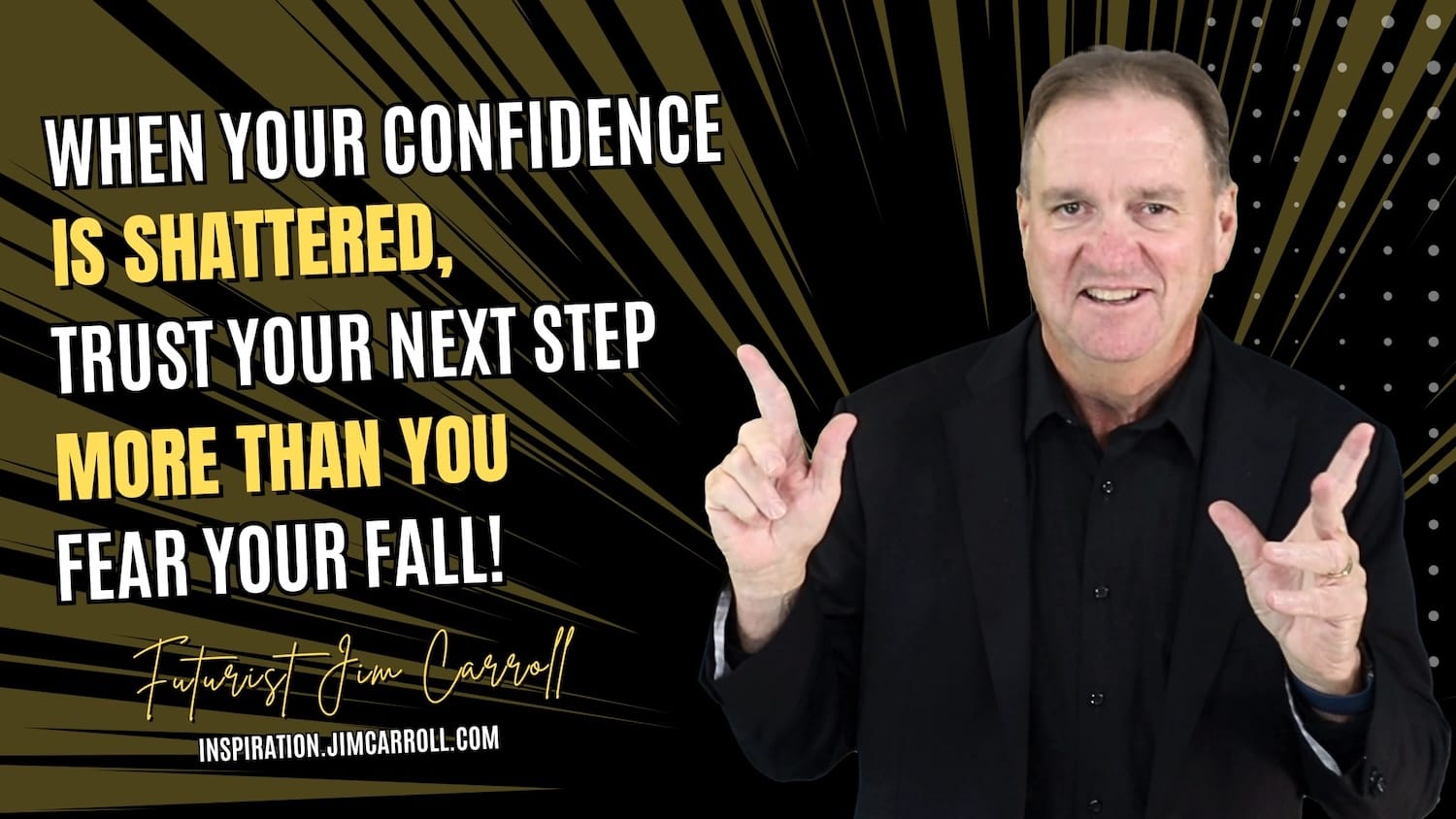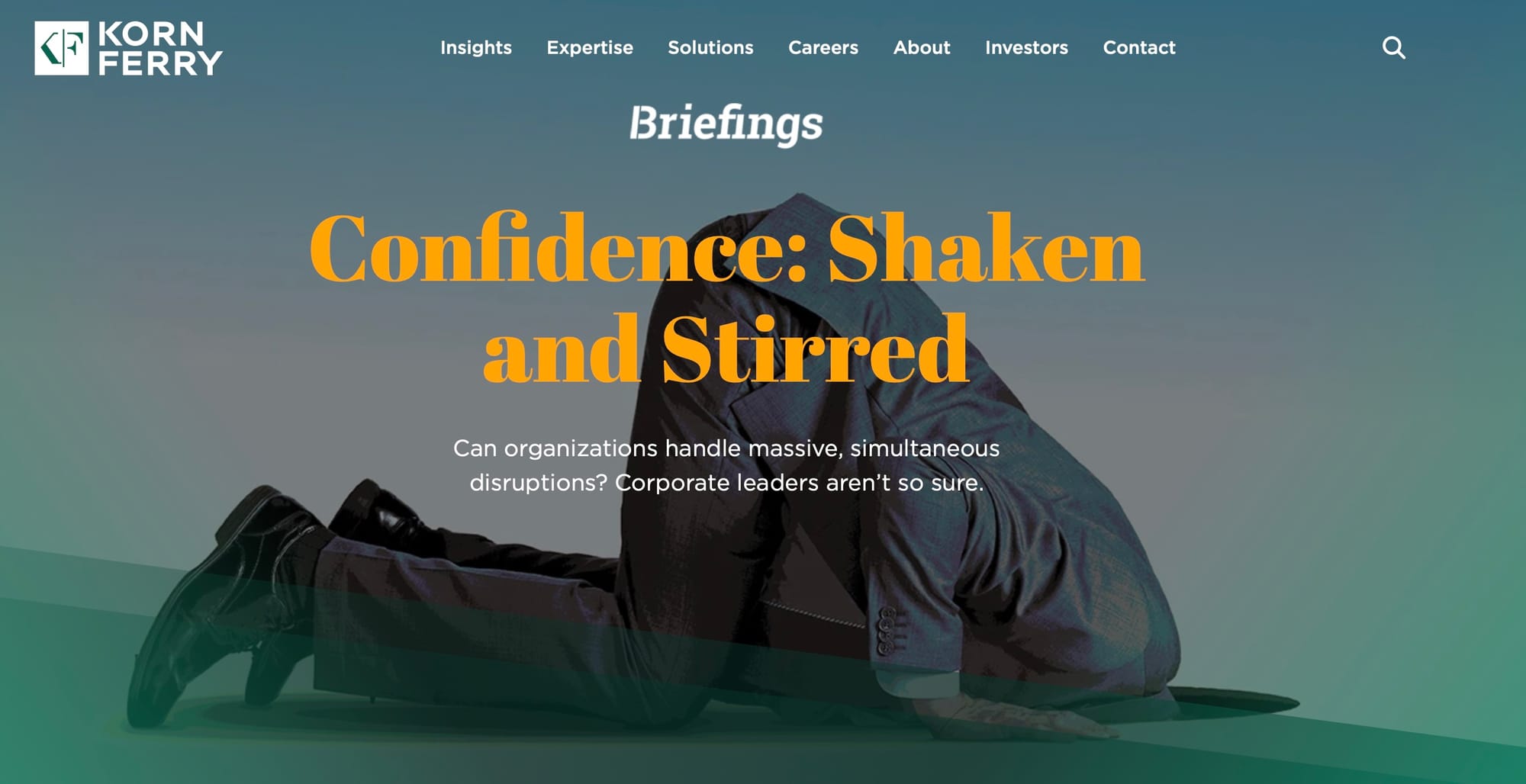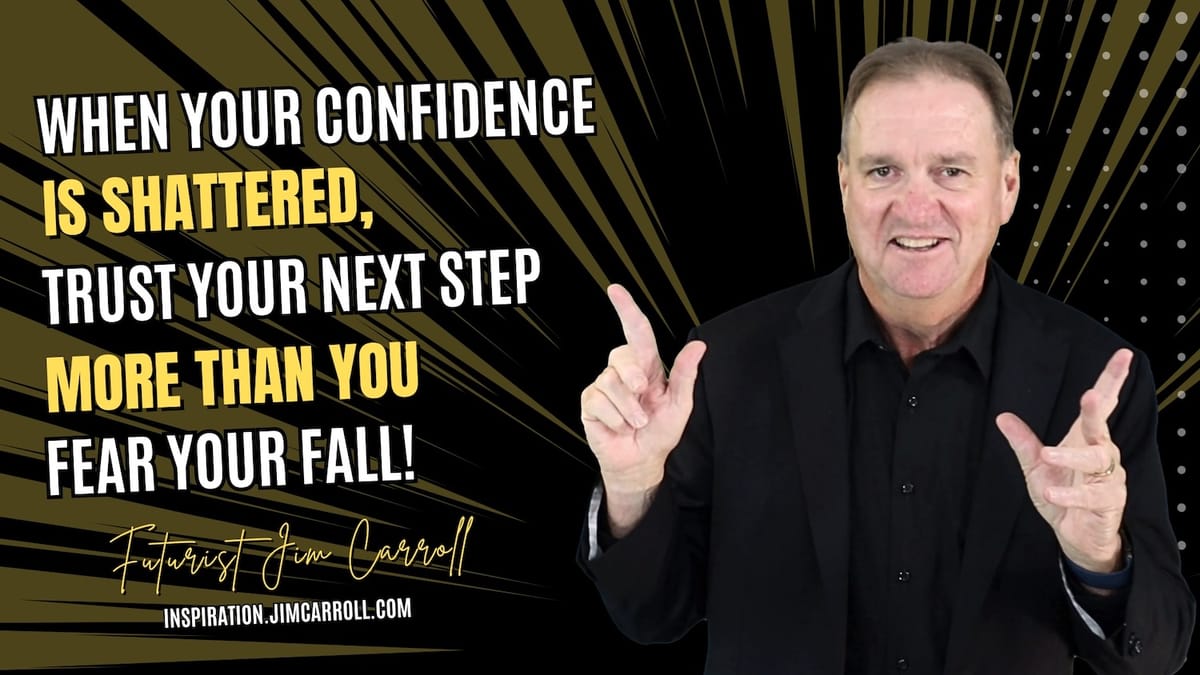"When your confidence is shattered, trust your next step more than you fear your fall!" - Futurist Jim Carroll

The Korn Ferry This Week In Leadership newsletter is the insight gift that keeps on giving - it's always full of useful, powerful, and recent information. [ link ] One article that caught my attention? Confidence: Shaken And Stirred. With the subtitle Can organizations handle massive, simultaneous disruptions? Corporate leaders aren't so sure; it fits right in with the types of issues I often cover here. [ link ]

What's it about? Simply, a recent survey of 250 CEOs and board members revealed a stunning lack of confidence among corporate leaders regarding their ability to manage simultaneous, massive global disruptions. That's no surprise, but it certainly helps to put things in context - I see a lot of organizations struggling with change, trends, volatility, and the sheer speed with which everything is unfolding.
But the article notes that, faced with geopolitical upheaval, accelerating AI change, and worldwide economic slowdowns, business confidence is at a modern low. Think about that! No wonder it seems like everyone is just spinning their wheels without moving forward, and is just focused on putting out all the fires around them.
The key points of this crisis are clear:
- Massive simultaneous risk: Corporate leaders are grappling with a confluence of massive, out-of-control problems occurring simultaneously, including changing trade policies, geopolitical upheavals, and AI disruption.
- An increased risk perception: 63% of leaders reported that their firm's risk had increased since 2024.
Low Confidence Levels: Only 11% were extremely confident that their organizations could handle the current level of risk. - Geopolitical risk Concern: Leaders expressed the least confidence in their ability to handle geopolitical risk. No kidding.
There's not a lot of confidence in their ability to manage this risk. The survey reported that the only risk category where more than half (52%) expressed confidence was regulatory and compliance risk. The rest? A stunning lack of confidence!
The article goes on to note what leaders should be doing to try to mitigate this risk. First step? Project assurance that they can manage it (even though they think they can't), to prevent employee demoralization. Yikes! Didn't the captain of the Titanic do that? Yes, but at least he was showing confidence!
But even so, it's necessary, and the article advises a few key actions. First off, remind people of the mission: Leaders can bolster confidence by reminding themselves of their core purpose ("why"). The article notes that they should use this era of heightened risk as an opportunity: leaders should recognize that risk can present an opportunity to capitalize on change. That's precisely the story I tell in my Dancing in the Rain book - it's confirmation that the book is on the right track. You can grab the book here.
What it really comes down to is this - the challenge for modern leaders is to continually develop and enhance the ability to navigate these constant high-velocity risks. That demands a deep, unshakeable self-assurance that extends beyond quarterly forecasts. It demands developing confidence in the face of uncertainty and volatility.
This is precisely the issue I've emphasized in my "Daily Inspiration" posts, providing the philosophical guidance needed to bridge this CEO confidence gap. I went back to a few of my posts over the years which get into the confidence issue:
- Confidence is earned through action: Leaders cannot wait for certainty; they must create it through bold steps. As I wrote: "Confidence is the result of embracing the challenge of confronting the unknown!" This emphasizes that confidence is a result of engaging with risk, not a condition for it.
- Belief is the foundation of daring: The failure of leaders often begins with internal doubt. To make the necessary strategic decisions, conviction must precede the movement. "Believe that you can so that you know you will do!" underscores that self-belief is the engine of momentum, banishing complacency.
- Defying the status quo: True leadership confidence includes the conviction to ignore detractors and challenge the corporate norm that suppresses innovation. "Prove them wrong!" and "Disruptors value defiance over blind obedience!" are direct calls to action for leaders who must fight internal and external forces to achieve bold growth.
- Avoiding Arrogance: While advocating for bold confidence, I temper it with caution against the very overconfidence mentioned in the business summary: "Beware the dangerous illusion of invincibility!" True assurance is grounded in humility and vigilance, not the dangerous perspective that past success guarantees future performance.
The world is chaos. Which means you must lead with conviction; execution through action is your only certainty.
You can't wait for certainty, right? But what you can do is build your own confidence through bold, defiant action.
Confidence is broken.
When that is reality, enhancing your confidence matters.
That's why you need to trust your next step more than you fear the fall!
Confidence: Shaken and Stirred
Can organizations handle massive, simultaneous disruptions? Corporate leaders aren’t so sure.
Korn Ferry, September 26, 2025
You don’t become the top boss without a pretty good track record of tackling risk. At one time or another in any CEO’s career—perhaps at multiple times—they’ve probably faced a massive problem that was seemingly out of anyone’s control. Whatever it was, the CEO not only confidently solved the problem, but also took the business to new heights. Most board directors have similar experiences, too, either while serving as the top leader themselves or working on a strong, high-performing team.
But in 2025, so many massive problems seem to be out of control simultaneously: trade policies changing daily, geopolitical upheavals, AI’s disruption of nearly everything, and economic slowdowns worldwide—to name just four. The world’s corporate chiefs have noticed, and they’re not exactly brimming with confidence that they can handle them.
In its first annual top leadership survey, Korn Ferry asked 250 CEOs and board members at large organizations across the world about the dangers their firms currently face. Some 63 percent of respondents said their firm’s risk had increased since 2024. (Only 3 percent said it had decreased.) Just 11 percent said they were extremely confident their organizations could handle that risk, and just 51 percent said that they were extremely or very confident. “The low confidence figures are stunning,” says Jane Edison Stevenson, a Korn Ferry vice chair and global leader of the firm’s Board and CEO Succession practice.
Of all the major risks they face, CEOs and directors say they’re least confident about geopolitical risk. That’s understandable, says leadership consultant Jimmie Lee, since the current US administration is upending several decades of norms. This has pushed many leaders worldwide into being more reactive than proactive. “We don’t know how to predict what comes next,” Lee says. Just 21 percent of respondents said they were extremely or very confident about handling geopolitical risk; fewer than half were moderately confident. But it’s not as if corporate leaders feel overwhelming assurance about handling any of the big issues facing them. Indeed, in only one area of risk did more than half of CEOs and directors express confidence about their firms’ preparation: regulatory and compliance risk. Even then, only 52 percent of them did so.
Experts say CEOs and directors need to project confidence, even if they’re uncertain, in order to be effective. Employees can be left demoralized—and become less productive—when they sense the boss is directionless. Similarly, outside investors might agitate for change if they feel a CEO or board can’t execute. CEOs can strengthen their confidence, Lee says, by reminding themselves of purpose—both their own and the organization’s. Having purpose in mind allows them not only to make long-term strategic decisions, but also to intelligently consider any necessary course corrections. “Your ‘why’ is your insulator,” he says. At the same time, bosses should remind themselves that risk isn’t all bad. “Many times people look at risk as a four-letter word and don’t realize that it can be an opportunity to capitalize on change,” says Dennis Carey, a Korn Ferry vice chairman and co-leader of the firm’s Board Services practice.
From a director’s perspective, there’s nothing particularly new about the process of how to analyze risk, says Arie Brish, a management professor at the Bill Munday School of Business at St. Edward’s University who currently sits on corporate boards in the US and UK. Make a list of all the risk factors, calculate the probability of each one occurring (high, medium, or low), and estimate its potential impact on the business (again: high, medium, or low). Focus on the risks that are both high probability and high impact. What’s challenging, Brish says, is having the discipline to create an objective list of risks and engage in honest conversations about them with management, then prompt management to develop responses. Don’t take no for an answer, he says. “I’ve heard too many times comments from executives such as ‘Just talking about it will impact morale.’”
The issue of building and enhancing confidence in an era of uncertainty is covered in detail in Jim Carroll's latest book, Dancing in the Rain: How Bold Leaders Grow Stronger in Stormy Times. Learn more here.

